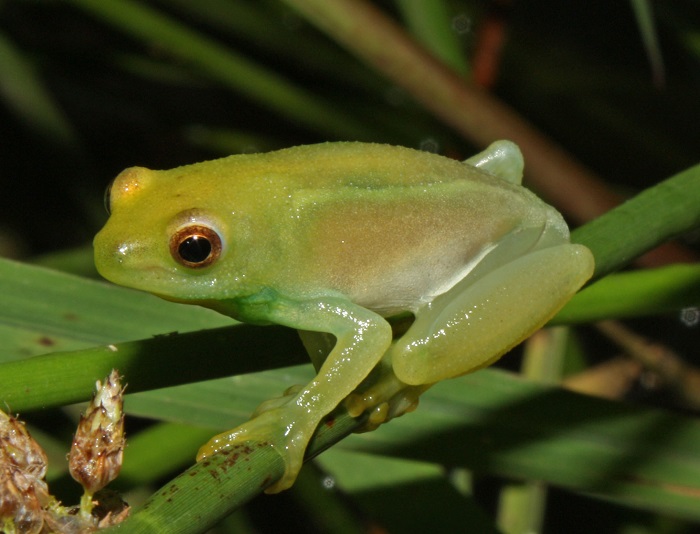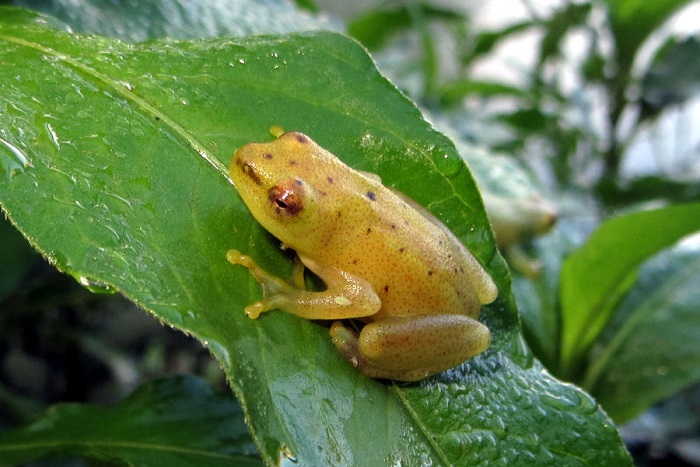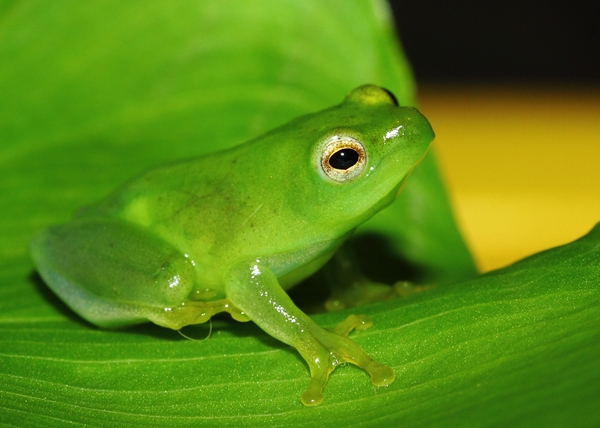View the above photo record (by Ryan van Huysteen) in FrogMAP here.
Find the Water Lily Frog in the FBIS database (Freshwater Biodiversity Information System) here.
Family Hyperoliidae
WATER LILY FROG – Hyperolius pusillus
Cope, 1862
Habitat
H. pusillus inhabits open savanna and grassland, breeding in shallow pans, ponds, vleis and dams with water lilies Nymphaea sp., or at least some form of floating vegetation. In the atlas region it occurs in a variety of bushveld vegetation types, from Coastal Bushveld-Grassland along the coast of the Eastern Cape and KwaZulu-Natal, to Mixed Lowveld Bushveld in the low-lying areas of Limpopo Province, east of the Great Escarpment. During the atlas survey, breeding populations were also found in ponds in plantations of pine and Eucalyptus, south of Piet Retief (2730BA, 2730BC).

Photo by Luke Verburgt
Behaviour
Very little is known about the non-breeding behaviour of H. pusillus. In Durban (2931CC), breeding takes place from the beginning of October to the end of March (Alexander 1987). Males form dense choruses on floating vegetation and leave the breeding site only in the early hours of the morning to ascend into surrounding trees (Passmore and Carruthers 1995). On occasions, males have even been found calling from the tree canopy at the start of the chorus in the early evening, apparently stimulated to call from these atypical sites by the chorus at the breeding site.

Photo by Luke Verburgt
Choruses are characterised by high levels of aggressive behaviour between males, especially in the early evening when calling is at its peak. At such times, a minimum distance of 25 cm is maintained between calling males by means of the advertisement call, an encounter call, and physical contact between calling males (Cleminson 1991). During territorial disputes, males often butt one another with their vocal sacs (Passmore and Carruthers 1995).
About 500 light green eggs are laid in groups of 20–120, in a single layer between the overlapping margins of lily leaves, with the jelly surrounding the eggs acting as a glue to keep the leaves together (Wager 1965). While this specialized oviposition site reduces predation, it may also be a limiting factor at sites where population densities are high (Telford 1982).
H. pusillus adults feed on ants and flying termites, and are preyed upon by the Yellowbilled Egret Egretta intermedia (Channing 2001). The call sites favoured by this species make it particularly vulnerable to predation by pisaurid spiders (L.R. Minter and A. Turner pers. obs.).

Photo by Jean-Paul Brouard
Status and Conservation
H. pusillus is a relatively abundant species, often occurring in large numbers at breeding sites. Populations in developed and managed areas, such as golf courses and parks, appear to be stable, and some have been observed to re-establish themselves following serious disturbance. In Durban, several individuals translocated from Bluff Nature Reserve to Pigeon Valley established a new breeding population (Alexander 1990).
This species is protected in a number of established national and provincial conservation areas, and seems to require no additional conservation action at present. It is protected from collection by provincial conservation ordinances in the relevant provinces.

Photo by Geoff Prosser
Distribution
H. pusillus is distributed from southern Somalia, southward through East Africa to Mozambique, eastern Zimbabwe and Swaziland (Poynton and Broadley 1987; Channing 2001). Within the atlas region it occurs as far south as Cebe (3228DA) in the Eastern Cape. The species usually occurs in low-lying coastal areas but, further inland in the northern parts of the atlas region, it is found at higher altitudes, as in Malawi and northwestern Botswana (Channing 2001).
This species has an unmistakable call, and the atlas data are reasonably complete and reliable.

Further Resources
Virtual Museum (FrogMAP > Search VM > By Scientific or Common Name)
More common names: Waterleliepadda (Afrikaans)
Recommended citation format for this species text:
Alexander GJ, Tippett RM. Water Lily Frog Hyperolius pusillus. BDI, Cape Town.
Available online at http://thebdi.org/2021/11/16/water-lily-frog-hyperolius-pusillus/
Recommended citation format:
This species text has been updated and expanded from the text in the
2004 frog atlas. The reference to the text and the book are as follows:
Alexander GJ 2004 Hyperolius pusillus Water Lily Frog. In Minter LR
et al 2004.
Minter LR, Burger M, Harrison JA, Braack HH, Bishop PJ, Kloepfer D (eds)
2004. Atlas and Red Data Book of the Frogs of South Africa, Lesotho and
Swaziland. Smithsonian Institution, Washington, and Avian Demography
Unit, Cape Town.

Photo by Vaughan Jessnitz

